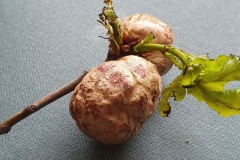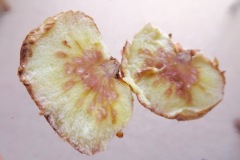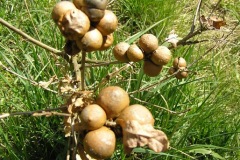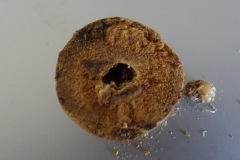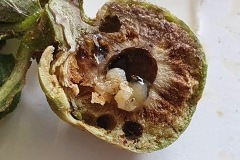Oak Apple and Marble Gall
On the meeting to Shaw Wood we saw two oak galls which are sometimes both referred to as oak apples so I thought I’d send a few photos to explain the difference. Apologies if you already know this info.
Both galls are induced by gall wasps known as cynipids.
Most species of cynipids have alternating generations and specifically the two wasps that induce Oak apples and Marble galls both have a life cycle involving two generations.
Oak apples
Oak apples, induced by the wasp Biorhiza pallida, represent the sexual generation and the asexual generation is induced on oak rootlets. Each oak apple contains many small chambers each of which houses a larva. See one cut in half below
The oak apples appear in late spring/early summer, the larvae eat and pupate inside. Adults chew their way out in late June/July when the apple has usually fallen from the tree.
Marble galls
Marble galls, induced by the gall wasp Andricus kollari represent the asexual generation and appear on our native oaks. This is a wasp which requires a different species of oak ie Turkey Oak for the sexual generation.
Inside each marble gall will be an egg which will develop into an asexual female which when mature will exit the gall and seek out a Turkey oak in which to lay its eggs. The ensuing sexual generation induces tiny pointed galls in the Turkey oak buds.
Large galls such as marble galls may also house more than one species of gall wasp besides the gall causer and thus may have multiple exit holes. They may occur singly or in groups as the image below shows.
These other species which may inhabit a marble gall are unable to cause galls themselves so make use of the nutrients and shelter provided by the gall causer by laying their eggs either in the outer gall ( the thick wall around the central chamber ) or in or on the developing larva. Those which lay their eggs in the outer gall are inquilines which may or may not cause the death of the gall causer by either competing for its food and possibly starving it to death or crushing it to death when more chambers are created.
The ones which lay their eggs in the inner chamber are called parasitoids and always cause the death of the host larva either by feeding on it from the outside or laying their eggs inside feeding on it from within. Together they form a community which may include as many as 50 insects!
Left: Gall with one chamber. Right: Gall with several chambers in the outer wall.
